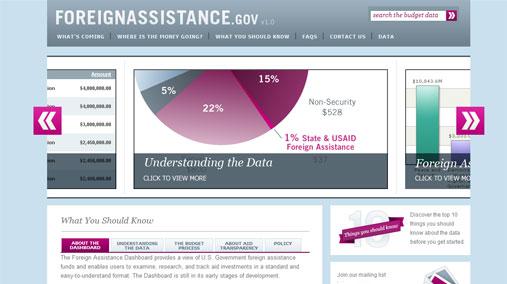Foreign Assistance Dashboard: Aid Transparency About Where US Aid Is Going

Every year the United States gives out around $50 billion in aid to developing countries around the world. This means the United States gives out twice as much in foreign aid as the next four counties on the list of major international donors (UK, Japan, France, and Germany).
So, where is this money going? The U.S. Department of State and USAID have developed a new tool to help in answering that question. In late 2011 the U.S. signed the International Aid Transparency Initiative, a voluntary multi-national strategy to make information about foreign aid more transparent, accessible, and understandable. Launched in 2013, the U.S. Foreign Assistance Dashboard provides a way to view U.S. foreign assistance funds in a standard, easy to understand, format.
The dashoard enables a wide spectrum of stakeholders in the U.S. aid process to examine, research, and track U.S. funding. It presents data in two ways: First, the website presents data in user friendly graphics in specific categories such as funding received by a particular country, sector, or agency. Information can also be accessed in machine-readable form, allowing users to execute manual queries and download data sets.
Critics of the program note that while the Dashboard is a step forward for transparency, agencies have been lagging in posting information to the Dashboard. They have also noted that data on the Dashboard is not presented in a clear format, or that information is incomplete.
I decided to take the site for a spin to see just what information I could garner from a search. Last summer I traveled to Tbilisi and Batumi, Georgia, so I decided to look into U.S. aid to the country. Using the "Where is the Money Going?" drop down menu I clicked on "Recipient Country/Region" and arrived at a color coded map of the world, which presented a breakdown of how much aid a country received as I ran my cursor over it. Rolling over Georgia, I learned that over $62 million has been requested in aid to Georgia for the 2014 fiscal year. Clicking on the country I arrived at a page presenting an overview of relations between the U.S. and Georgia as well as a brief history of U.S. aid to the country. I could also see aggregated data on aid spent by each granting agency to the country as well as a breakdown in transaction data for each project and entity that was funded to work in Georgia for the year. This included how much money had been allocated and actually spent for each specific program so far in 2013, proividing me with some basic information on aid to Georgia in a relatively rapid fashion. In particular, I learned that a majority of MCC money going to Georgia is spent on Conflict Mitigation and Reconciliation (CMR). This made me wonder how much money the U.S. is spending in total on CMR, so I moved to the page outlining sector-specific allocations and almost immediately discovered that, while CMR is a major issue in Georgia, it is infact one of the lowest overall funded sub-sectors within the U.S. programs on Peace and Security.
It is clear that the Dashboard is in its early stages of development. At this time data present on the site is confined to that of USAID and the Millenium Challenge Corporation. The site cites that future versions of the Dashboard with include, “ budget, financial, and program data in a standard form from all U.S. Government agencies receiving or implementing foreign assistance, humanitarian, and/or development funds.” There is even an outline presented which displays the sequence of the order in which U.S. government agency’s aid programs will be added to the dataset. As agencies continue to upload and update information to the site it will continue to grow in its usefulness and ability to depict accurately the disbursement of US aid to foreign countries.
